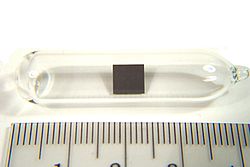Advantages
The primary physical advantage of thorium fuel is that it uniquely makes possible a breeder reactor that runs with slow neutrons, otherwise known as a thermal breeder reactor. [6] These reactors are often considered simpler than the more traditional fast-neutron breeders. Although the thermal neutron fission cross section (σf) of the resulting 233
U
is comparable to 235
U
and 239
Pu
, it has a much lower capture cross section (σγ) than the latter two fissile isotopes, providing fewer non-fissile neutron absorptions and improved neutron economy. The ratio of neutrons released per neutron absorbed (η) in 233
U
is greater than two over a wide range of energies, including the thermal spectrum. A breeding reactor in the uranium–plutonium cycle needs to use fast neutrons, because in the thermal spectrum one neutron absorbed by 239
Pu
on average leads to less than two neutrons.
Thorium is estimated to be about three to four times more abundant than uranium in Earth's crust, [21] although present knowledge of reserves is limited. Current demand for thorium has been satisfied as a by-product of rare-earth extraction from monazite sands. Notably, there is very little thorium dissolved in seawater, so seawater extraction is not viable, as it is with uranium. Using breeder reactors, known thorium and uranium resources can both generate world-scale energy for thousands of years.
Thorium-based fuels also display favorable physical and chemical properties that improve reactor and repository performance. Compared to the predominant reactor fuel, uranium dioxide (UO
2), thorium dioxide (ThO
2) has a higher melting point, higher thermal conductivity, and lower coefficient of thermal expansion. Thorium dioxide also exhibits greater chemical stability and, unlike uranium dioxide, does not further oxidize. [6]
Because the 233
U
produced in thorium fuels is significantly contaminated with 232
U
in proposed power reactor designs, thorium-based used nuclear fuel possesses inherent proliferation resistance. 232
U
cannot be chemically separated from 233
U
and has several decay products that emit high-energy gamma radiation. These high-energy photons are a radiological hazard that necessitate the use of remote handling of separated uranium and aid in the passive detection of such materials.
The long-term (on the order of roughly 103 to 106 years) radiological hazard of conventional uranium-based used nuclear fuel is dominated by plutonium and other minor actinides, after which long-lived fission products become significant contributors again. A single neutron capture in 238
U
is sufficient to produce transuranic elements, whereas five captures are generally necessary to do so from 232
Th
. 98–99% of thorium-cycle fuel nuclei would fission at either 233
U
or 235
U
, so fewer long-lived transuranics are produced. Because of this, thorium is a potentially attractive alternative to uranium in mixed oxide (MOX) fuels to minimize the generation of transuranics and maximize the destruction of plutonium. [22]
Disadvantages
There are several challenges to the application of thorium as a nuclear fuel, particularly for solid fuel reactors:
In contrast to uranium, naturally occurring thorium is effectively mononuclidic and contains no fissile isotopes; fissile material, generally 233
U
, 235
U
or plutonium, must be added to achieve criticality. This, along with the high sintering temperature necessary to make thorium-dioxide fuel, complicates fuel fabrication. Oak Ridge National Laboratory experimented with thorium tetrafluoride as fuel in a molten salt reactor from 1964 to 1969, which was expected to be easier to process and separate from contaminants that slow or stop the chain reaction.
In an open fuel cycle (i.e. utilizing 233
U
in situ), higher burnup is necessary to achieve a favorable neutron economy. Although thorium dioxide performed well at burnups of 170,000 MWd/t and 150,000 MWd/t at Fort St. Vrain Generating Station and AVR respectively, [6] challenges complicate achieving this in light water reactors (LWR), which compose the vast majority of existing power reactors.
In a once-through thorium fuel cycle, thorium-based fuels produce far less long-lived transuranics than uranium-based fuels, some long-lived actinide products constitute a long-term radiological impact, especially 231
Pa
and 233
U
. [17] On a closed cycle,233
U
and 231
Pa
can be reprocessed. 231
Pa
is also considered an excellent burnable poison absorber in light water reactors. [23]
Another challenge associated with the thorium fuel cycle is the comparatively long interval over which 232
Th
breeds to 233
U
. The half-life of 233
Pa
is about 27 days, which is an order of magnitude longer than the half-life of 239
Np
. As a result, substantial 233
Pa
develops in thorium-based fuels. 233
Pa
is a significant neutron absorber and, although it eventually breeds into fissile 235
U
, this requires two more neutron absorptions, which degrades neutron economy and increases the likelihood of transuranic production.
Alternatively, if solid thorium is used in a closed fuel cycle in which 233
U
is recycled, remote handling is necessary for fuel fabrication because of the high radiation levels resulting from the decay products of 232
U
. This is also true of recycled thorium because of the presence of 228
Th
, which is part of the 232
U
decay sequence. Further, unlike proven uranium fuel recycling technology (e.g. PUREX), recycling technology for thorium (e.g. THOREX) is only under development.
Although the presence of 232
U
complicates matters, there are public documents showing that 233
U
has been used once in a nuclear weapon test. The United States tested a composite 233
U
-plutonium bomb core in the MET (Military Effects Test) blast during Operation Teapot in 1955, though with much lower yield than expected. [24]
Advocates for liquid core and molten salt reactors such as LFTRs claim that these technologies negate thorium's disadvantages present in solid fuelled reactors. As only two liquid-core fluoride salt reactors have been built (the ORNL ARE and MSRE) and neither have used thorium, it is hard to validate the exact benefits. [6]




